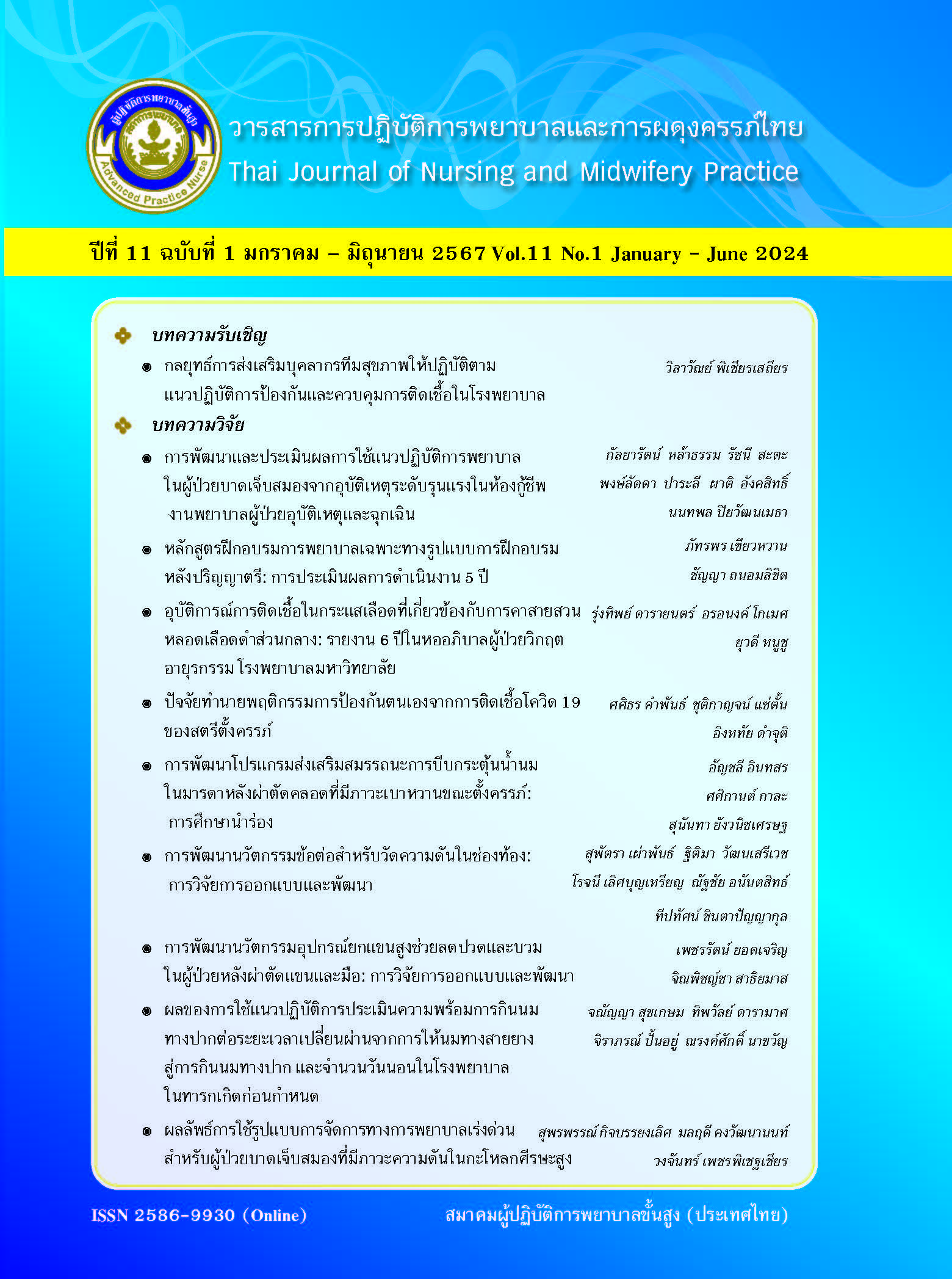Implementation Outcomes of a Fast-Track Nursing Management Model for Patients with Traumatic Brain Injury with Increased Intracranial Pressure
Main Article Content
Abstract
This retrospective study aimed to evaluate the implementation outcomes of a fast-track nursing management model for patients with traumatic brain injury (TBI) and increased intracranial pressure (IICP) at a tertiary hospital. The model was developed based on the Donabedian quality of care framework, which includes structure, process, and outcomes. The model was implemented in 2018 and revised until integrated in routine work. Data were collected from the “Neurobyte” database for the fiscal years 2021-2023. Descriptive statistics were used for data analysis. Results showed that the number of patients with severe TBI were 113, 123, and 164, respectively. They were middle-aged adults. One-third of the patients underwent brain surgery. Outcomes evaluated in each aspect were as follows: For structure, neurosurgical nurses demonstrated knowledge of the care of patients with IICP higher than the predetermined criterion (> 70%). For process, although the mean of emergency department waiting time before admission to the ward was more than 100 minutes was longer than the standard (< 60 min), the mean preoperative time for urgent surgery (both order to operating room and order to time-in operation) was less than the standard (< 30 minutes and < 60 minutes, respectively). For patient outcomes, the mortality rates declined from 41.6% to 31.7%. The percentage of patients with good recovery at discharge increased from 40.7 to 48.2. The median length of hospital stay was 6-7 days. The study findings specified the following issues for further improvement: evaluation of care outcomes should commence at the emergency room, and quality improvement should be focused continuously.
Downloads
Article Details

This work is licensed under a Creative Commons Attribution-NonCommercial-NoDerivatives 4.0 International License.
References
CDC [Internet]. 2023 [cited 2023 Dec 10]. Available from: https://www.cdc.gov/TraumaticBrainInjury/data/index.html
Health data center (HDC) [Internet]. 2023 [cited 2023 Dec 15]. Available from: https://hdcservice.moph.go.th/hdc/reports/report.php. Thai.
Phuenpathom N, Srivilaikul T, editors. Clinical practice guideline for traumatic brain injury. Bangkok: Prosperous Plus; 2020. Thai.
Prachuablarp C. Increased intracranial pressure in patients with brain pathology: A dimension of evidence-base nursing practice. JTNMC. 2018; 33(4): 15-28. Thai.
Tripathy S, Ahmad SR. Raised intracranial pressure syndrome: A stepwise approach. Indian J Crit Care Med.2019; 23(2Suppl): S129-35. doi:10.5005/jp-journals-10071-23190.
Shim Y, Kim J, Kim HS, et al. Intracranial pressure monitoring for acute brain injured patients: When, How, What should we monitor. Korean J Neurotrauma. 2023; 19(2): 149-61. doi: 10.13004/kjnt.2023.19.e32.
van Erp IA, Michailidou I, van Essen TA, et al. Tackling neuroinflammation after traumatic brain injury: Complement inhibition as a therapy for secondary injury.Neurotherapeutics. 2023; 20(1): 284-303. doi: 10.1007/s13311-022-01306-8.
Meyfroidt G, Bouzat P, Casaer MP, et al. Management of moderate to severe traumatic brain injury: An update for the intensive. Intensive Care Med. 2022; 48: 649-66. doi: 10.1007/s00134-022-06702-4.
Hsieh SL, Hsiao CH, Chiang WC, et al. Association between the time to definitive care and trauma patient outcomes: Every minute in the golden hour matters. Eur J Trauma Emerg Surg. 2022; 48(4): 2709-16. doi: 10.1007/s00068-021-01816-8.
Neurosurgery Service plan. Meeting summary: Results of the development of the neurosurgery patient care system, Vachira Phuket Hospital and network. June 4, 2018. Vachira Phuket Hospital. Chatfah Conference Room.
Punlaisee S, Phuenpathom N, Veerasarn K, editors. Clinical practice guideline for traumatic brain injury. Bangkok: Tana Press; 2013. Thai.
Kitbunyonglers S, Petpichetchian W. Evidencebased fast track nursing management in care of patients with traumatic brain injury having increased intracranial pressure: A case study. TJNMP. 2018; 5(1): 5-18. Thai.
Donabedian A. The quality of care: how can it be assessed?.JAMA.1988; 260(12): 1743-8. doi: 10.1001/jama.260.12.1743.
Donabedian A. Evaluating the quality of medical care.Milbank Q.2005; 83(4): 691-729. doi: 10.1111/j.1468-0009.2005.00397.x.
Liu Y, Aungsuroch Y. Current literature review of registered nurses’ competency in the global community. J. Nurs. Scholarsh. 2018, 50(2): 191-199.
Government Big Data Institute (GBDi), Big Data Institute (Public Organization). Government big data analytics framework [Internet]. 2022 [cited 2024 Feb 9]. Available from: https://gbdi.depa.or.th/.../government-big-data.../
McDonal ME. Systematic assessment of learning outcomes: Developing multiple-choice exams. Sudbury, MA: Jones and Bartlett; 2002.
Varghese R, Chakrabarty J, Menon G. Nursing management of adults with severe traumatic brain injury: A narrative review. Indian J. Crit. Care Med. 2017; 21(10): 684-79. doi:10.4103/ijccm.IJCCM_233_17.
. Taweekul S, Reunchan P. The development of nursing service system in head injury patients from traffic accidents in emergency room of Chiangrai Prachanukroh hospital. J DMS. 2019; 14(3): 46-56. Thai.
Cnossen MC, Scholten AC, Lingsma HF, et al. Adherence to guidelines in adult patients with traumatic brain injury: A living systematic review. J Neurotrauma.2021;38(8): 1072-85. doi: 10.1089/neu.2015.4121.


